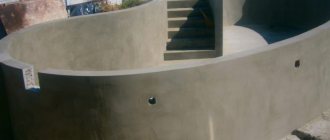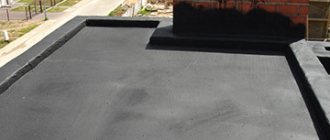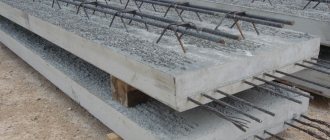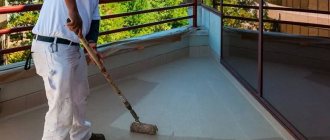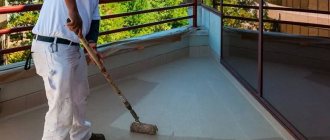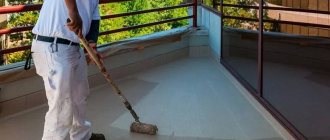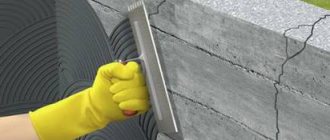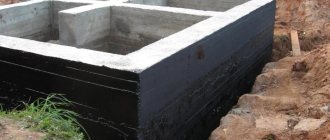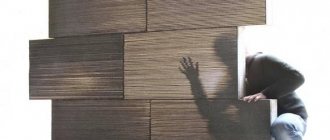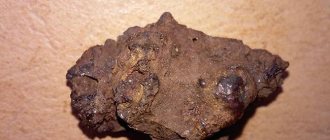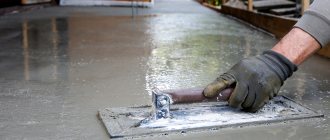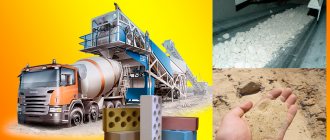Penetrating waterproofing for concrete is used to protect the structure from moisture. This method can be used as the main measure indoors (for example, a basement). In this case, the possibility of damage to the protective layer is eliminated, since the composition penetrates into the concrete structure, preventing its deformation from the inside.
Operating principle
The composition is fluid, thanks to which it has the ability to penetrate into the structure of materials. The mechanism of action of waterproofing mixtures is based on this property. There are many capillaries in the structure of concrete. These are the smallest channels through which liquid enters deep.
When penetrating into the concrete structure, liquid waterproofing interacts with water. As a result, the process of crystallization occurs. The capillaries are sealed tightly, and liquid can no longer penetrate through them. This allows you to protect the structure from destruction.
Liquid glass
The components of the insulator are mixtures of chemical compounds used to make glass, hence the name. Sodium silicate solutions are necessary when bitumen coating is not desired. Liquid glass for waterproofing concrete closes microvoids with crystals that do not allow moisture to pass through. Good antiseptic properties are known that block the appearance of fungus.
Advantages and disadvantages
Features of the product in various situations can be both positive and negative factors:
- increases the hardness of the base;
- crystallizes quickly.
Strong adhesion to the concrete surface and rapid hardening require precision and accuracy of application. Due to the specifics of the product, it is better to entrust the work to a specialist.
The positive points include:
- resistance of the coating to mechanical stress;
- acceleration of finishing work;
- low cost of the insulator;
- increasing fire resistance.
The significant disadvantages of the product are:
- lack of elasticity;
- difficulties of self-installation.
Recommendations for application
Application of the product can be by coating or penetrating method. The first is suitable for sealing joints and leaking areas. The solution smoothes out unevenness and penetrates into the concrete. Liquid glass is often mixed into construction mixtures to improve its protective properties.
It is recommended to carry out insulation work with gloves, since when water gets in, an active alkaline reaction begins. If areas of the skin are affected, the affected area must be washed with running water. In general, the composition is harmless.
Before applying liquid glass, the working base must be cleaned of dirt with a coarse brush, degreased, and primed. If puddles have formed on top, or the surface is covered with frost, then waterproofing is not performed. The base is treated at a temperature of at least 5° C. The solution is applied in several layers, at half-hour intervals, avoiding air bubbles.
In what cases is it used?
Penetrating waterproofing for concrete is used in a number of cases:
- treatment of wet surfaces, no additional drying required;
- increasing the service life of reinforced concrete structures, while reducing the likelihood of metal rusting, since moisture does not penetrate deep into the material;
- restoration of the surfaces of concrete walls, floors, supports, if the process of their destruction has begun due to frequent contact with moisture (building material crumbles, cracks appear);
- carrying out waterproofing works of above-ground and underground parts of the facility;
- constant erosion of the base of a concrete building by groundwater, flooding of the facility, which leads to the washing out of the foundation material and destruction of the building;
- sealing water tanks.
Why is waterproofing needed?
Concrete in appearance seems to be a very durable material - it’s not for nothing that in everyday life the word “reinforced concrete” is used to describe something strong, rough and reliable. However, this material has a lot of small pores, which can be seen if you look at it closely and closely. These pores resemble the structure of the pores of a sponge, and they operate on the same principle. So, for example, groundwater can easily get inside the building through these pore paths, destroy the fittings, spoil the microclimate in the room and lead to the appearance of mold and mildew on the walls of the building. At a minimum, the plaster begins to peel off from wet concrete, and then other consequences of the lack of waterproofing of materials appear.
Penetrating waterproofing for concrete
Also, water, due to the chemical reactions occurring inside the concrete, causes the material to become brittle. Concrete begins to crumble, albeit not immediately, but over time it cracks and can cause the entire house to sag. That is why it is so important to carry out a number of waterproofing works during the construction of any structures, be it a residential building, a garage, an industrial building, etc.
Water causes concrete to become brittle
Main characteristics
When considering the use of deep penetration waterproofing as the main protective measure, it is necessary to take into account the properties of the composition and its effect on the foundation of the facility. When comparing with other insulation methods, pay attention to the pros and cons of using penetrating mixtures.
The main characteristic of such a composition is the ability to restore the protective layer formed as a result of a chemical reaction during the interaction of the penetrating mixture and concrete. With constant contact with water, the crystals can be destroyed. However, they are gradually recovering.
As a result, moisture protection continues to operate for a long period.
Advantages
Positive traits:
- the composition can be used at the construction stage and in cases where the facility has long been put into operation;
- it is allowed to treat a moistened concrete surface, while the material does not lose its properties; on the contrary, upon contact with moisture, the penetrating insulation immediately begins to act;
- after applying the composition, the period of operation of the object increases several times;
- this method of protection is suitable for all types of buildings;
- installation work is accelerated, since often after applying the penetrating composition, other types of insulation are not used;
- eliminates the risk of corrosion of metal elements of reinforced concrete structures;
- resistance to chemical attack is noted;
- breathability of the processed material;
- high degree of mobility;
- resistance to temperature fluctuations;
- The material can withstand a wide range of temperatures.
Flaws
There are much fewer disadvantages of using penetrating compounds. Note:
- for treating brick structures and buildings made of foam concrete, foam blocks, it is not advisable to use this method of waterproofing, since the chemical crystallization reaction will not occur in the structure of the brick, and foam concrete is too porous a material; when using a penetrating composition, not all capillaries will be filled;
- high price;
- when performing certain types of work, it is necessary to use a penetrating composition for waterproofing concrete simultaneously with other types of moisture-proof materials;
- you need to carefully prepare the surface: it is cleaned, dusted and degreased, and then moistened.
Using penetrating waterproofing
Step 1. The first step is to thoroughly clean the surface to be treated of all contaminants. The surface can be treated with a grinder and a wire brush to roughen the walls. It is also important to remove efflorescence - they can become an obstacle to the penetration of the composition into the concrete. A Karcher-type water jet will also help remove dirt and sand the walls at once.
Surface treatment with a grinder
Prices for angle grinders (grinders)
Angle grinders (grinders)
Step 2. Now you can start preparing the treatment solution. It is important to understand that each brand of mixture must be prepared strictly according to the instructions given on the package. In this case, the mixture from the bag must be diluted with a precisely measured amount of water.
Preparation of the solution
Step 3. After this, the mixture must be mixed well with water. This is best done with a construction mixer.
Mixing the mixture
Step 4. The finished waterproofing solution must be applied to a wall moistened with ordinary water using a brush.
Application of the finished solution
Step 5. In some cases, you can also apply the solution using your hand. It is important to carefully treat the entire wall to ensure the proper level of waterproofing. When working with your hands, use durable nitrile gloves.
You can also apply the solution by hand
Step 6. After applying the solution, it is recommended to periodically moisten the wall with water during the day. Next, you need to keep the surface moist for about a week. But if the pool has been treated, then within a day it can be filled with water.
The wall needs to be moistened periodically
Types of compositions
When choosing a method of protecting a concrete structure, different materials are compared based on their properties. This allows you to determine the appropriate option. In addition, in this way a material is selected for additional protection of the concrete surface treated with a penetrating composition.
Liquid
This group includes:
- liquid glass;
- liquid rubber.
Such materials are safe for humans and are produced in finished form. After treatment, a coating is formed that provides a high degree of protection for concrete. Moisture does not penetrate through a layer of liquid glass or rubber, but this is only possible if the surface has been properly prepared. As a result, the adhesion of materials is enhanced. In this case, no water gets between the liquid waterproofing layer and the concrete.
By comparison, this type of material does not require preheating, as is the case with bitumen. Working with liquid glass and rubber is also much easier. The advantages include the ability to apply the composition to an uneven surface.
However, the cost of liquid rubber and glass is much higher than the dry mixture for waterproofing concrete surfaces.
Coating type
Materials of this group are characterized by viscosity. These include bitumen mastic. During processing, high adhesion of waterproofing and concrete is ensured, due to which the structure is protected from water. However, the disadvantage is the lack of protection against moisture, which negatively affects concrete when dampness appears.
This is due to the inability of bitumen mastic to penetrate deep into the concrete. However, the combination of coating and penetrating waterproofing provides more reliable protection against moisture than when using these materials separately.
Concrete paint
This group of materials includes coloring compounds that do not allow water to pass through. This option is often chosen if there is no experience in performing finishing work, since applying paint does not require special knowledge.
Concrete is processed quickly; a spray bottle is used for this, which allows you to regulate the amount of coloring material and also avoid the formation of smudges.
Paint can also be used to protect foundation seams. This method of waterproofing is used when finishing swimming pools and tanks that come into contact with water.
Pasting type
In this case, work is carried out in 2 stages:
- bitumen mastic is applied to the prepared surface (leveled, cleaned, treated with a primer);
- when the layer of coating insulation has dried, the roofing material is unrolled, while a gas burner is used to heat the bitumen, resulting in a durable coating that reliably adheres to the concrete and does not allow water to pass through.
This method of protection is superior to the method based on the use of roll material alone. As a result, such a coating quickly deforms, since it is not fixed to the surface by anything. And the roofing felt itself, which is often used as roll insulation, quickly deforms when backfilled.
What kind of water prevents us from living and why?
All water that can harm a house from the outside is conventionally divided into surface and underground.
Superficial ones appear on the site during floods, spring melting of snow and precipitation. They fall into the soil and sink through the pores into its deeper layers. Storm sewers successfully combat these waters.
And of all types of groundwater, residents of country houses need to focus on the following:
- Capillary waters. Formed in the area above groundwater. Capillary rise can break the crushed stone layer, and to prevent the crushed stone from mixing with the soil, geotextiles are used.
- Groundwater The layer of water that is located closest to the surface on a waterproof layer of rock. To combat them, different types of drainage are used (ring, etc.), some of which can only be done with the involvement of hydraulic engineers and other specialists.
- Verkhovodka. A type of groundwater that seasonally accumulates in the upper water-saturated layer of soil above clay or loamy rocks. If the soil on the site is clay or dense loam, but water appears in the basement after a couple of years of operation, this is perched water. You can deal with high water using wall drainage and preventive measures: organizing the relief, installing blind areas and storm drains, and compacting backfills.
Waterproofing can have "operational and economic advantages" over the measures described in the table, and successfully protect basements from corrosion and water intrusion. It would be more correct not to get by with waterproofing the basement alone, but to completely close off the possibility of water getting to the house by making a storm drain, a gravel area with a drainage system, and a sand cushion under the foundation. But if mistakes have already been made during construction, and even in dry weather there is water in the basement, and in heavy rain you can swim there, internal waterproofing can be a real salvation.
Application Features
Instructions for performing waterproofing:
- The quality of the surface of a concrete structure is checked if the object is old. If necessary, remove the layer of plaster. Then a finishing material is applied to level the surface.
- If the base is severely damaged, it may be necessary to strengthen the structure, which is implemented through additional reinforcement.
- When large cracks form, they are widened, then sealed with a cement composition.
- The seam connections of the foundation and concrete slabs of other buildings are partially opened, for which the gating method is used. These areas are protected with a sealing compound. The same principle is used to fill leaks around communications that exit through a concrete structure.
- After preparation, the surface is cleaned, and it is important to remove not only dirt, but also dust.
- The concrete structure is degreased on the side where it is planned to apply the penetrating compound.
- Prepare waterproofing material. To apply it, use a spray gun, brush or roller.
When the penetrating waterproofing method is used, joint joints are opened only if the concrete is crumbling in these areas.
Review of popular brands
The materials differ in composition. This affects the properties of penetrating waterproofing, determines its effectiveness and reliability, as well as its scope. When choosing, pay attention to the cost. It should be taken into account that prices in Moscow and the regions for the same formulations may differ.
Penetron
These are universal mixtures; they are used to protect various types of private and industrial facilities from moisture: swimming pools, bathrooms, foundations, wells and water tanks. Main components: sand, chemically active substances. The average consumption of penetrating insulation of this brand is 1 kg/1 m².
Penetron Admix
Used as a liquid additive for concrete. The material is characterized by high levels of frost resistance, moisture resistance, and strength. The dry mixture is mixed with water. The substance is added at the concrete preparation stage to the concrete mixer. As a result, the resistance of the entire structure to moisture increases.
Lakhta
Products of this brand are produced in dry form. The range of materials includes special products for protecting the joints of concrete structures. According to the principle of action, such compositions do not differ from other mixtures: when penetrating to a certain depth into concrete, the substance enters into a chemical reaction with water, forming crystals.
The price of Lakhta products is lower than the common analogue Penetron, but the quality of the materials of these brands is approximately equal.
Calmatron
The material helps strengthen the concrete structure, protects against minor leaks that contribute to the destruction of walls, floors, and foundations. The advantages of Kalmatron products include versatility. The material of this brand is used not only to protect concrete, but is also applied to brick surfaces, structural elements made of foam concrete, and aerated concrete. The use of such a composition is limited by changes in pH levels within the range of 3-11 units.
Penecrit
This material belongs to the Penetron group of waterproofing materials. It is often used in conjunction with Penebar pads. The last of the varieties of materials is designed to protect seams from the destructive effects of moisture, as well as seal cracks in areas where communications pass through a concrete structure.
Penecrit is prepared in small quantities (up to 7 kg), because it hardens quickly, as a result of which it loses its properties. Before using this mixture, the concrete surface is treated with water, then with Penetron. When it is necessary to fill deeper gaps and cracks, crushed stone is additionally used for strengthening. Leaks wider than 3 cm should not be filled in one approach.
Peneplug
This material is used to seal damaged concrete structures where there are active leaks. The required result is obtained due to the ability of the composition to set quickly. For this reason, do not prepare a large amount of the mixture. Use 1 kg of dry composition and 150 g of water. As a result, a thick mass is obtained, with the help of which the area with an existing leak is repaired.
The material sets within 60 seconds. However, the speed of this process decreases if the water in the area with an active leak is cold.
The amount of Peneplug mixture should not exceed 1/2 the volume of the gap. This is due to the fact that after the material hardens, this area is treated with the penetrating composition Penecrit. Then a viscous mixture of Penetron is applied, which fills the remaining volume of the gap.
Ditch, seal, waterproof
Our user with the nickname ALEXUS_81 has constant water in the basement because “a goblin brigade of monolithic workers poured screed onto the floor without any waterproofing or reinforcement.” Because the floor is unprotected, he doesn't see the point in digging out the basement and applying waterproofing to uneven surfaces. All the water has already been pumped out by the pump, but where it comes from is not visible, so the plan to combat basement flooding is as follows:
- To groove and seal all joints between concrete walls and floors;
- Treat all basement walls and floors with penetrating insulation so that there is no more “capillary action.”
ALEXUS_81FORUMHOUSE Member
If all the cracks are caulked and the capillary movement of water is stopped, then there should be no water flow into the basement. Although one unsealed hole may be enough for flooding.
This is what the underground garage of our user with the nickname Magma looked like before the basement was waterproofed:
Water penetrated into the basement through the capillaries of the concrete and through the junction of the floor and the wall. We had to make grooves to dump water into a drainage well with a pump. Water began to flow quite actively from the opened seams, the pump worked in continuous mode. To stop the water, we first had to make hydraulic seals, and then seal the grooves with joint compound. At the last stage, the concrete surface was treated with a penetrating compound.
This is the result that we managed to obtain.
